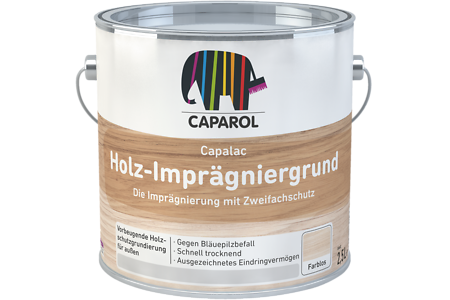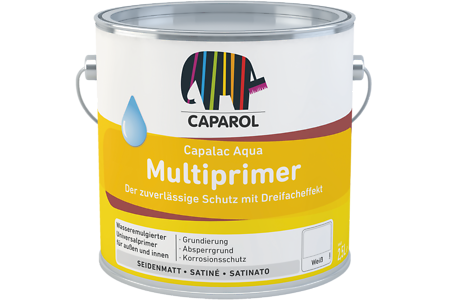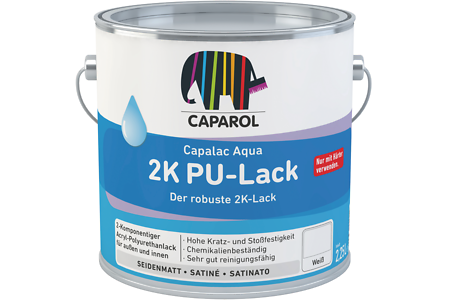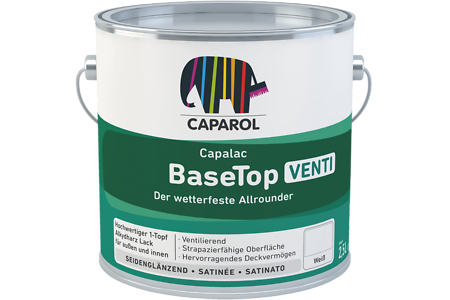Field of Application
1-pot-enamel for protective thick-film coatings and colourful designing of building components made of iron, steel, zinc, galvanised steel, aluminium, copper, unplastizised (rigid) PVC, wooden parts interiors and dimensionally stable exterior wood components. Corrosion protection for iron and steel. Unsuitable for coatings on roofing and anodised aluminium. Do not use white colour shades on heating systems in order to avoid yellowing (apply Capalac Heizkörperlack /radiator enamel).
Material Properties
- Excellent adhesion.
- High opacity (hiding/covering power) on component surfaces and edges.
- Durable protection due to excellent weather resistance.
- High solids content allows a better dry film thickness.
- 1-Pot-Enamel System: Facilitates priming, intermediate and finishing coats with one product.
- Test report for corrosiveness category C4, duration of conservation "long” on steel and galvanised steel according to DIN EN ISO 12944 part 6.
- Available as enamel and mica types.
- Tintable via ColorExpress in numerous colour shades.
- Free of aromatic hydrocarbons.
Material Base / Vehicle
Epoxy ester with non-aromatic solvents.
Packaging/Package Size
- White, Mica and RAL 9006:
750 ml, 2.5 litres, 10 litres and 35 kg - ColorExpress:
1 litre, 2.5 litres and 10 litres
Colours
- Standard:
Enamel: White
Mica types: Mica and approx. RAL 9006 - ColorExpress:
A multitude of enamel and mica tones can be tinted via the ColorExpress stations, e.g. RAL 9007.
When colour shades with a lower opacity (hiding/covering power) are used, e.g. red, orange or yellow, it is advisable to apply a first (priming) coat of product, tinted in a matching priming system colour, available via ColorExpress.
Note: If necessary, apply one transparent sealing coat of Capalac Kunstharz-Klarlack (clear coat) on intensively or dark tinted Capalac Dickschichtlack coatings to avoid a slight abrasion of pigments.
Mica types are corrosion-inhibiting coatings. Their surface is matt and semi-rough according to RAL and German National Railways Standard (TL/TP-KOR).
Only suitable for interior use:An additional transparent sealing coat of Capalac Kunstharz-Klarlack leads to a more stressable interior surface and cleaning is facilitated.
Colour Changes Occur With Mica Types:
In comparison to printed colour fan decks. Between Mica types of different manufacturers. In case of repairs. When different coating methods are used (e.g. paint brush, roller or spray application, powder coating and liquid coating).
Colour Resistance according to BFS Data Sheet No. 26:
Binder: Class B
Pigmentation: Group 1 to 3, depending on the colour.
Gloss Level
- Enamel types:
Silk-matt/semi-gloss (mid sheen) - Mica shades:
Matt (flat)
Storage
Keep in a cool place, in tightly closed cans.
Density
Approx. 1.3 g/cm³
Suitability according to Technical Information No. 606 Definition of Application Areas
| Interior 1 | Interior 2 | Interior 3 | Exterior 1 | Exterior 2 |
| + | + | + | + | + |
| (–) inapplicable / (○) of limited suitability / (+) suitable | ||||
Suitable Substrates
Dimensionally stable wood component parts, iron, steel, zinc, aluminium, unplastizised (rigid) PVC, and sound existing paint coatings.
The substrate must be clean, sound/stable, dry, and free all materials that may prevent good adhesion.
Maximum permissible moisture content in dimensionally stable wood: 13 %.
Do not use for coatings on roofing and anodised aluminium.
Substrate Preparation
Wooden Parts:
Sand the surface in fibre direction, clean thoroughly, remove exuding wood extractives, e.g. wood resin/rosin and resin galls, cut sharp edges (see BFS Data Sheet No. 18).
Iron, Steel:
Derust according to industry standard SA 2 ½ (blasting) as per DIN EN ISO 12944-4. At low stress conditions (e.g. indoors – without condensation water or aggressive influences) the surface may thoroughly be derusted to purity grade ST 3, either mechanically or manually.
Zinc, Galvanised Steel:
Wash with Multistar cleaner using sanding pad or with light ammonia solution or by sweep spraying according to BFS Data Sheet No. 5.
Unplastizised (Rigid) PVC:
Wash with Multistar cleaner using sanding pad or with light ammonia solution according to BFS Data Sheet No. 22.
Aluminium:
Wash with Multistar cleaner using sanding pad or with nitro-thinner or phosphoric acid solution using sanding pad according to BFS Data Sheet No. 6.
Copper:
Wash with Multistar cleaner using sanding pad.
Existing Enamel Coatings:
Roughen (sand) the surface slightly and/or treat with alkali. Remove unsound/unstable coatings.
Method of Application
Guidelines for Spray Application:
| Ø Nozzle | Pressure | Advice | ||
| Airless | Enamel | 0.009 – 0.013 inch | 180 – 200 bar | Membrane pump and piston pump |
| Mica | 0.015 – 0.019 inch | 180 – 200 bar | Only to be used with piston pump |
Surface Coating System
| Substrate | Use | Substrate Preparation | Impregnation | Priming Coat | Intermediate Coat | Finishing Coat |
| Wood, derived timber products | interior | roughening | – | Capalac Dickschichtlack | if required Capalac Dickschichtlack | Capalac Dickschichtlack |
| Dimensionally stable wood | exterior | BFS Nr. 18 | Capalac Holz-Imprägniergrund | |||
| Iron, steel | interior/exterior | derust/degrease | – | |||
| Zinc (galvanised substrates) | interior/exterior | BFS Nr. 5 | – | |||
| Aluminium | interior/exterior | BFS Nr. 6 | – | |||
| Copper | interior/exterior | Multistar/sanding pad | - | |||
| Unplasticised/rigid PVC | interior/exterior | BFS Nr. 22 | – | |||
| Sound existing coats of paint1) | interior/exterior | roughening/alkali treatment | Prepare and prime defects according to the substrate | |||
| Advice: Adhesion must be tested in advance for powder coatings, coil coatings and other critical substrates by a trial coating. |
Application:
Capalac Dickschichtlack can be applied by brush, roller or spraying equipment. Stir well before use and thin with white spirit, if necessary. Mica paints should be applied with spraying equipment in order to achieve an even surface. A blushing effect may occur on large areas, e.g. when application is divided into multiple work steps.
Corrosion Protection on Steel with Capalac Dickschichtlack:
Coating systems for corrosiveness categories C2, C3, C4 according to DIN EN ISO 12944-5
Surface preparation: Blasting to purity grade SA 2½ (DIN EN ISO 12944-4)
No. | Priming Coat | µm1) | Intermediate Coat | µm1) | Finishing Coat | µm1) | Total Reference Coating Thickness µm1) | Corrosiveness Category | ||||||||
| C22) | C32) | C42) | ||||||||||||||
| L | M | H | L | M | H | L | M | H | ||||||||
| 1 | Capalac- Dickschichtlack e.g. RAL 7036 | 60 | Capalac-Dickschichtlack e.g. RAL 7036 | 60 | 120 | |||||||||||
| 2 | Capalac-Dickschichtlack Mica | 80 | Capalac-Dickschichtlack Mica | 80 | 160 | |||||||||||
| 3 | Capalac-Dickschichtlack e.g. RAL 7036 | 60 | Capalac-Dickschichtlack e.g. RAL 7036 | 60 | Capalac-Dickschichtlack e.g. RAL 7036 | 60 | 180 | |||||||||
| 43) | Capalac-Dickschichtlack Mica | 80 | Capalac-Dickschichtlack e.g. RAL 7036 | 60 | Capalac-Dickschichtlack e.g. RAL 7036 | 60 | 200 | |||||||||
| 53) | Capalac-Dickschichtlack | 80 | Capalac-Dickschichtlack Mica | 80 | Capalac-Dickschichtlack Mica | 80 | 240 | |||||||||
| 1) | Reference layer thickness |
| 2) | Explanations for corrosiveness categories see below. |
| 3) | With verification of suitability (Test Report) according to DIN EN ISO 12944 part 6 for system No. 5. |
| Blue= | Suitable |
| White = | Unsuitable |
Corrosion Protection on Galvanised Steel with Capalac Dickschichtlack (Duplex System):
Coating system for corrosiveness category C2, C3, C4 according to DIN EN ISO 12944-5
Surface preparation: "Sweepen” · slightly grit/shot- blasting (DIN EN ISO 12944-4)
No. | Priming | µm1) | Intermediate Coat | µm | Finishing Coat | µm | Total Reference Coating Thickness µm | Corrosiveness Category | ||||||||
| C2 | C3 | C4 | ||||||||||||||
| L | M | H | L | M | H | L | M | H | ||||||||
| 1✱ | Capalac- Dickschichtlack e.g. RAL 5010 | 60 | Capalac-Dickschichtlack e.g. RAL 5010 | 60 | 120 | |||||||||||
| 2✱ | Capalac-Dickschichtlack Mica | 80 | Capalac-Dickschichtlack Mica | 80 | 160 | |||||||||||
| ✱ With verification of suitability (Test Report) according to DIN EN ISO 12944 part 6. |
Explanations:
Corrosiveness categories (see DIN EN ISO 12944 part 2)
| Category/Loads | Examples for typical environmental conditions or loads in moderate climate. | |
| exterior | interior | |
| C2 Low | Atmospheres with low pollution. In the majority of cases rural areas. | Unheated buildings where condensation may occur, e.g. storehouses, sports halls. |
| C3 Middle (Moderate) | Atmosphere in cities and industrial areas, moderate pollution caused by sulphur dioxide. Coastal areas with low salt loads. | Production rooms with a high humidity and some air pollution, e.g. facilities for the production of foods, laundries, breweries, creameries. |
| C4 High | Industrial areas and coastal areas with moderate salt loads. | Chemical facilities, swimming pools, boathouses above sea water. |
Duration of Protective Effect:
(See DIN EN ISO 12944 part 1 and part 5)
Duration of protective effect: This means the lifetime of a coating system up to the first repair. The time spans, mentioned below, are based on experience. They enable the customer to specify a repair program under economic factors. Duration of protective effect in years (no warranty time !)
| Time Period | Duration of protective effect (years) |
| Low (L) | 2–5 |
| Middle (M) | 5–15 |
| High (H) | over 15 |
Consumption
| Consumption / Coating Thickness: | |||||
| Used Tools | Material Type | Consumption/m2 | Average Consumption/m2 | Average Wet Film Thickness | Average Dry Film Thickness |
| Brush / Roller | Enamel type (unicoloured) | 100–125 ml | approx. 115 ml | approx. 115 µm | approx. 65 µm |
| Mica and DB colours | 125–160 ml | approx. 140 ml | approx. 140 µm | approx. 80 µm | |
| RAL 9006 | 100–125 ml | approx. 115 ml | approx. 115 µm | approx. 60 µm | |
| Spraying Equipment | Enamel type (unicoloured) | 100–125 ml | approx. 115 ml | approx. 115 µm | approx. 65 µm |
| Mica and DB colours | 150–180 ml | approx. 160 ml | approx. 160 µm | approx. 80 µm | |
| RAL 9006 | 125–150 ml | approx. 135 ml | approx. 135 µm | approx. 70 µm | |
These reference values for consumption and layer thickness may vary depending on the nature and condition of the substrate. The exact consumption is best established by a trial coating (test area) on site. |
Application Conditions
Lower Temperature Limit for Application and Drying:
+5 °C for product, substrate and ambient air.
Drying/Drying Time
| at 20 °C and 65% relative humidity | dust dry | touch dry | recoatable | completely dry |
| after hours | 4 | 8 | 24 | approx. 5 days |
Lower temperatures and higher humidity extend the drying time. Adding 5% by volume of Capalac PU-Härter (hardener) leads to accelerated drying and stressability of the coating.
Tool Cleaning
Immediately after use with white spirit.
Special Risks (Hazard Note) / Safety Advice (Status as at Date of Publication)
Capalac Dickschichtlack base white and transparent:
Flammable liquid and vapour. May cause drowsiness or dizziness. Harmful to aquatic life with long lasting effects. Repeated exposure may cause skin dryness or cracking. Keep out of reach of children. Keep away from open flames/hot surfaces. - No smoking. Do not breathe vapours/ spray. Do not get in eyes, on skin, or on clothing. Use only outdoors or in a well-ventilated area. Avoid release to the environment. IF SWALLOWED: Rinse mouth. Do NOT induce vomiting. Bis(1,2,2,6,6-pentamethyl-4-piperidyl)sebacate, Cobalto-neodecanato, Methyl 1,2,2,6,6-pentamethyl-4-piperidyl sebacate.
Capalac Dickschichtlack base EG:
Flammable liquid and vapour. May cause drowsiness or dizziness. Toxic to aquatic life with long lasting effects. Repeated exposure may cause skin dryness or cracking. Keep away from heat, hot surfaces, sparks, open flames and other ignition sources. No smoking. Do not breathe vapours/ spray. Use only outdoors or in a well-ventilated area. Avoid release to the environment. Do not get in eyes, on skin, or on clothing. IF SWALLOWED: Rinse mouth. Do NOT induce vomiting. Contains Bis(1,2,2,6,6-pentamethyl-4-piperidyl)sebacate, Methyl 1,2,2,6,6-pentamethyl-4-piperidyl sebacate. May produce an allergic reaction.
Disposal
Materials and all related packaging must be disposed of in a safe way in accordance with the full requirements of the local authorities. Particular attention should be made to removing wastage from site in compliance with standard construction site procedures.
In Germany: Only completely emptied clean cans/containers should be given for recycling. Dispose containers with residues of liquid product via waste collection point accepting old paints and enamels. Dispose dried/hardened product residues as construction site/demolition/municipal or domestic waste.
EU limit value for the VOC content
of this product (category A/i): 500 g/l (2010). This product contains max. 500 g/l VOC.
Product Code Paints and Enamels
M-LL01
Substances of Content - Declaration
Epoxy resin ester, titanium dioxide, coloured pigments, metal effect pigments, mineral fillers, aliphatics, glycol ether, additives.Further Details
See Safety Data Sheet (MSDS).Customer Service Centre
Tel.: +49 6154 71-71710Fax: +49 6154 71-71711
e-mail: kundenservicecenter@caparol.de
International Distribution: Please see www.caparol.com
Technical information
Sustainability data sheet
- Sustainability Fact Sheet Capalac mix Dickschichtlack Basis Weiß
- Sustainability Fact Sheet Capalac Dickschichtlack Weiß
Material safety data sheet
- System instructions Capalac Dickschichtlack Basis EG
- System instructions Capalac Dickschichtlack Basis Transp.
- System instructions Capalac Dickschichtlack RAL 9006
- System instructions Capalac Dickschichtlack DB 701
- System instructions Capalac mix Dickschichtlack Basis Weiß
- System instructions Capalac Dickschichtlack Weiß
Technical information
Sustainability data sheet
- Sustainability Fact Sheet Capalac mix Dickschichtlack Basis Weiß
- Sustainability Fact Sheet Capalac Dickschichtlack Weiß
Material safety data sheet
- System instructions Capalac Dickschichtlack Basis EG
- System instructions Capalac Dickschichtlack Basis Transp.
- System instructions Capalac Dickschichtlack RAL 9006
- System instructions Capalac Dickschichtlack DB 701
- System instructions Capalac mix Dickschichtlack Basis Weiß
- System instructions Capalac Dickschichtlack Weiß











